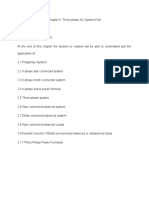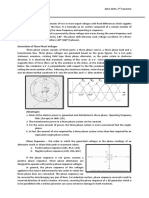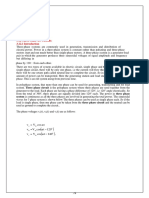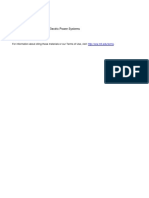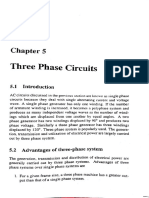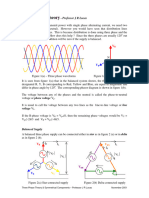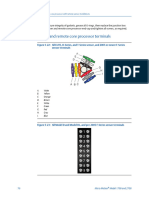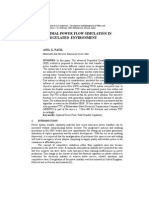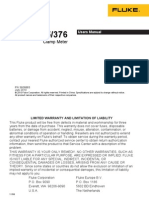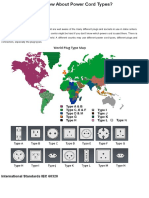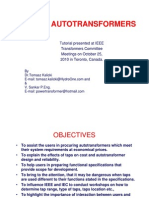UNIT – II
THREE PHASE BALANCED AND UNBALANCED CIRCUITS
Topics: Three phase circuits: Phase sequence (A-B-C & A-C-B) of source and load- Star and delta
connections-Relation between line and phase voltages and currents in balanced three phase
source phasor diagrams-Analysis of three phase balanced load circuits- Calculation of Active,
Reactive power, apparent power in balanced three phase systems.
Analysis of three phase unbalanced load circuits-Loop Method- Millman’s Theorem method-
Star Delta Transformation methods, phasor diagrams.
INTRODUCTION:
A system which utilizes only one winding and generates single alternating voltage and
current is known as a single-phase system.
A system which utilizes more than one winding is called a poly-phase system. It
produces as many induced voltages as the number of windings. The generation of electric
power is, however, three-phase in practice because, even though it is possible to have any
number of sources in a poly-phase system, the increase in the available power is not significant
beyond the three-phase system.
ADVANTAGES OF THREE-PHASE SYSTEMS:
A three-phase system has a number of advantages over a single-phase system.
i) The output of a three-phase machine generating electricity is more than the output of a
single-phase machine of the same size.
ii) The most commonly used three-phase induction motors are self starting. For single-phase
motors, a separate starting winding is required.
iii) Electrical power transmission from the generating station to the places of use is done by
transmission lines. It has been seen that three-phase power transmission is more economical
than single-phase power transmission.
iv) The power factor of three-phase systems is better than that of the single-phase systems.
v) Single-phase supply can also be obtained from a three-phase supply.
vi) The instantaneous power in a single-phase system is fluctuating with time giving rise to
noisy performance of single-phase motors. The power output of a symmetrical three-phase
system is steady.
vii) For rectification of AC into DC, the DC output voltage becomes less fluctuating if the number
of phases is increased.
GENERATION OF THREE PHASE VOLTAGES
The Three-phase voltages can be generated in a stationary armature with a rotating field
structure, or In a rotating armature with a stationary field as shown in Fig. (a) and (b).
Page-1
� The Single-phase voltages and currents are generated by single-phase generators as
shown in Fig.(c). The armature (here a stationary armature) of such a generator has only one
winding, or one set of coils. In a two-phase generator, the armature has two distinct windings,
or two sets of coils that are displaced 90° (electrical degrees) apart, so that the generated
voltages in the two phases have 90° phase displacement as shown in Fig.(d). Similarly, three-
phase voltages are generated in three separate but identical sets of windings or coils that are
displaced by 1200 electrical degrees in the armature, so that the voltages generated in them are
1200 apart in time phase, This arrangement is shown in Fig.(e). Here RR' constitutes one coil
(R-phase): YY’ another coil (Y-phase), and BB' constitutes the third phase (B-phase). The field
magnets are assumed in clockwise rotation.
Page-2
� The voltages generated by a three-phase alternator is shown in Fig.(e). The three
voltages are of the same magnitude and frequency, but are displaced from one another by 120 0.
Assuming the voltages to be sinusoidal, we can write the equations for the instantaneous values
of the voltages of the three phases. Counting the time from the instant when the voltage in
phase R is zero.
The equations are
At any given instant, the algebraic sum of the three voltages must be zero..
NOTE: THREE PHASE VOLTAGE WAVEFORM
Page-3
�BASIC DEFINITIONS:
1. Phase Sequence: The sequence in which the voltages in the three phases reach the
maximum positive value is called the phase sequence or phase order. From the phasor diagram
of a three-phase system, it is clear that the voltage in the coil R attains maximum positive value
first, next in the coil Y and then in the coil B. Hence, the phase sequence is R-Y-B.
Example: Determine the phase sequence of the set of voltages
Solution:
2. Phase Voltage: The voltage induced in each winding is called the phase voltage.
3. Phase Current: The current flowing through each winding is called the phase current.
4. Line Voltage: The voltage available between any pair of terminals or lines is called the line
voltage.
5. Line Current: The current flowing through each line is called the line current.
6. Symmetrical or Balanced System: A three-phase system is said to be balanced if the
(a) voltages in the three phases are equal in magnitude and differ in phase from one another by
120°, and
(b) currents in the three phases are equal in magnitude and differ in phase from one another by
120°.
Page-4
�7. Balanced Load: The load is said to be balanced if loads connected across the three phases
are identical, i.e., all the loads have the same magnitude and power factor.
8. Balanced supply: A set of three sinusoidal voltages (or currents) that are equal in
magnitude but has a phase difference of 120° constitute a balanced three-phase voltage (or
current) system.
9. Unbalanced supply: A three-phase system is said to be unbalanced when either of the
three-phase voltages are unequal in magnitude or the phase angle between the three phases is
not equal to 120°.
10. Unbalanced load: If the load impedances of the three phases are neither identical in
magnitude nor in phase angle, then the load is said to be unbalanced.
STAR AND DELTA CONNECTIONS
In order to reduce the number of conductors, the three windings are connected in the following
two ways: 1. Star or Wye connection 2. Delta or Mesh connection
STAR (OR) WYE CONNECTION:
In this connection, similar ends (start or finish) of the three phases are joined together
within the alternator as shown in Fig. The common terminal so formed is referred to as the
neutral point (N), or neutral terminal. Three lines are run from the other free ends (R, Y, B) to
feed power to the three-phase load.
The Figure represents a three-phase, four-wire, star-connected system. The terminals R,
Y, and B are called the line terminals of the source. The voltage between any line and the
neutral point is called the phase voltage (VRN, VYN, and VBN), while the voltage between any two
lines is called the line voltage (VRY, VYB, and VBR). The currents flowing through the phases are
called the phase currents, while those flowing in the lines are called the line currents. If the
neutral wire is not available for external connection, the system is called a three-phase, three-
wire, star-connected system. The system so formed will supply equal line voltages displaced
1200 from one another and acting simultaneously in the circuit like three independent single
phase sources in the same frame of a three-phase alternator.
Page-5
�DELTA OR MESH-CONNECTION:
In this method of connection, the dissimilar ends of the windings are joined together. i.e.
R’ is connected to Y, Y’ to B and B' to R as shown in Fig.
The three line conductors are taken from the three junctions of the mesh or delta
connection to feed the three-phase load. This constitutes a three-phase, three-wire, delta-
connected system. Here there is no common terminal; only three line voltages VRY, VYB, and VBR
are available.
These line voltages are also referred to as phase voltages in the delta-connected system.
When the sources are connected in delta, loads can be connected only across the three line
terminals, R, Y and B. In general, a three-phase source, star or delta can be either balanced or
unbalanced. A balanced three-phase source is one in which the three individual sources have
equal magnitude, with 1200 phase difference.
VOLTAGE, CURRENT AND POWER RELATIONS IN A BALANCED STAR-CONNECTED SYSTEM
RELATION BETWEEN LINE VOLTAGE AND PHASE VOLTAGE:
Page-6
�RELATION BETWEEN LINE CURRENT AND PHASE CURRENT:
It is clear that line current is equal to the phase current.
IL = Iph = IR = IY = IB
Phasor Diagram (Lagging Power Factor)
Figure shows the phasor diagram of a balanced star-connected inductive load.
Page-7
�Power:
The total power in a three-phase system is the sum of powers in the three phases. For a
balanced load, the power consumed in each load phase is the same.
VOLTAGE, CURRENT AND POWER RELATIONS IN A BALANCED DELTA-CONNECTED SYSTEM
RELATION BETWEEN LINE VOLTAGE AND PHASE VOLTAGE:
The Figure shows a balanced delta-connected system. From Fig., it is clear that only one phase
is connected between any two lines. Hence, the voltage between any two lines (VL) i.e. line
voltage is equal to phase voltage (Vph).
VL = Vph
Since the system is balanced, all phase voltages are equal but displayed by 1200.
VRY = VYB = VBR = VL = Vph
Page-8
�RELATION BETWEEN LINE CURRENT AND PHASE CURRENT:
PHASOR DIAGRAM (LAGGING POWER FACTOR):
The Figure shows the phasor diagram of a balanced delta connected system.
Page-9
�Power:
BALANCED Y/Δ AND Δ/Y CONVERSIONS
Thus, when three equal phase impedances are connected in delta, the equivalent star
impedance is one-third of the delta impedance.
Page-10
�COMPARISON BETWEEN STAR AND DELTA CONNECTIONS
ANALYSIS OF THREE PHASE BALANCED LOAD CIRCUITS
a) Balanced Three-Phase system – Delta load:
The Figure (a) shows a three-phase. three-wire, balanced system supplying power to a
balanced three-phase delta load. The phase sequence is RYB.
Let us assume the line voltage VRY = V∠00 as the reference phasor. Then the three source
voltages are given by
These voltages are represented by phasors in Fig(b). Since the load is delta-connected,
the line voltage of the source is equal to the phase voltage of the load. The current in phase RY,
IR will lag (lead) behind (ahead of) the phase voltage VRY by an angle Ф as dictated by the
nature of the load impedance. The angle of lag of IY with respect to VYB, as well as the angle of
lag of IB with respect to VBR will be Ф as the load is balanced. All these quantities are
represented in Fig.(b).
Page-11
�Page-12
�b) Balanced Three-Phase system – Star load:
The Figure(a) shows a three-phase, three-wire system supplying power to a balanced
three phase star connected load. The phase sequence RYB is assumed.
In star connection, whatever current is flowing in the phase is also flowing in the line.
The three line (phase) currents are IR, IY, and IB.
Page-13
�Page-14
�PHASE AND LINE VOLTAGES/CURRENTS FOR BALANCED THREE-PHASE SYSTEMS
Page-15
� ANALYSIS OF THREE PHASE UNBALANCED LOAD CIRCUITS
An unbalance exists in a circuit when the impedances in one or more phases differ from
the impedances of the other phases. In such a case, line or phase currents are different and are
displaced from one another by unequal angles. It is enough to solve problems, considering one
phase only on balanced loads; the conditions on other two phases being similar. Problems on
unbalanced three-phase loads are difficult to handle because conditions in the three phases are
different. However, the source voltages are assumed to be balanced. If the system is a three-
wire system, the currents flowing towards the load in the three lines must add to zero at any
given instant. If the system is a four-wire system, the sum of the three outgoing line currents is
equal to the return current in the neutral wire. In practice, we may come across the following
unbalanced loads:
(i) Unbalanced delta-connected load
(ii) Unbalanced three-wire star-connected load
(iii) Unbalanced four-wire star-connected load..
i) UNBALANCED DELTA-CONNECTED LOAD:
The Figure shows an unbalanced delta-load connected to a balanced three-phase supply.
The unbalanced delta-connected load supplied from a balanced three-phase supply does
not present any new problems because the voltage across the load phase is fixed. It is
independent of the nature of the load and is equal to the line voltage of the supply. The current
in each load phase is equal to the line voltage divided by the impedance of that phase. The line
current will be the phasor difference of the corresponding phase currents, taking VRY as the
reference phasor.
Assuming RYB phase sequence, we have
Page-16
�ii) UNBALANCED FOUR WIRE STAR-CONNECTED LOAD:
The Figure shows an unbalanced star load connected to a balanced 3-phase, 4-wire
supply.
The star point, NL, of the load is connected to the star point, NS of the supply. It is the
simplest case of an unbalanced load because of the presence of the neutral wire; the star points
of the supply Ns (generator) and the load NL are at the same potential. It means that the voltage
across each load impedance is equal to the phase voltage of the supply (generator), i.e. the
voltages across the three load impedances are equalized even though load impedances are
unequal, However, the current in each phase (or line) will be different. Obviously, the vector
sum of the currents in the three lines is not zero, but is equal to neutral current. Phase currents
can be calculated in similar way as that followed in an unbalanced delta-connected load.
Taking the phase voltage VRN = V∠0° V as reference, and assuming RYB phase sequences, we
have the three phase voltages as follows:
Page-17
�iii) UNBALANCED THREE WIRE STAR-CONNECTED LOAD:
In a three-phase, four-wire system if the connection between supply neutral and load neutral is
broken, it would result in an unbalanced three-wire star-load. This type of load is rarely found
in practice, because all the three wire star loads are balanced. Such system is shown in Fig.
Note that the supply star point (Ns) is isolated from the load star point (NL). The
potential of the load star point is different from that of the supply star point. The result is that
the load phase voltages are not equal to the supply phase voltage; and they are not only
unequal in magnitude, but also subtend angles other than 120° with one another. The
magnitude of each phase voltage depends upon the individual phase loads. The potential of the
load neutral point changes according to changes in the impedances of the phases that is why
sometimes the load neutral is also called a floating neutral point. All star-connected,
unbalanced loads supplied from poly-phase systems without a neutral wire have floating
neutral point; the phasor sum of the three unbalanced line currents is zero. The phase voltage
of the load is not 1/√3 of the line voltage. The unbalanced three-wire star load is difficult to
deal with. It is because load phase voltages cannot be determined directly from the given
Page-18
�supply line voltages. There are many methods to solve such unbalanced Y-connected loads.
Two frequently used methods are presented here. They are
(i) Star-delta conversion method, and
(ii) Millman's theorem method
(iii) Loop or Mesh Method
STAR-DELTA (or) DELTA-STAR CONVERSION METHOD
While dealing with currents and voltages in loads, it is often necessary to convert a star
load to delta load and vice-versa. The conversion formulae (like as using resistances) can be
applied even if the loads are unbalanced. Thus, considering Fig.(a), star load can be replaced by
an equivalent delta-load with branch impedances as shown.
Consider Fig.(b), delta load can be replaced by an equivalent star-load with branch impedances
as shown.
Page-19
� If the three-phase load is balanced, the balanced star-connected load having an
impedance Z1 in each phase as shown in the fig. The equivalent delta-connected load have an
impedance of Z2 in each phase as given by
Z2 = 3Z1
The star impedance in-terms of delta as Z1 = Z2/3
MILLMAN’S METHOD OF SOLVING UNBALANCED LOAD
Consider an unbalanced wye (Y) load connected to a balanced three-phase supply as
shown in Fig.(a). VRO, VYO and VBO are the phase voltages of the supply. They are equal in
magnitude, but displaced by 1200 from one another. VRO’, VYO’ and VBO’, are the load phase
voltages; they are unequal in magnitude as well as differ in phase by unequal angles. ZR, ZY and
ZB are the impedances of the branches of the unbalanced wye(Y) connected load.
The Figure(b) shows the triangular phasor diagram of the complete system. Distances
RY, YB and BR represent the line voltages of the supply as well as load. They are equal in
magnitude, but displaced by 1200. Here ‘O’ is the star-point of the supply and is located at the
centre of the equilateral triangle RYB. O’ is the load star point. The star point of the supply
which is at the zero potential is different from that of the star point at the load, due to the load
being unbalanced. O’ has some potential with respect to O and is shifted away from the centre
Page-20
�of the triangle. Distance O'O represents the voltage of the load star point with respect to the
star point of the supply VO’O.
[NOTE:
The unbalanced three-wire star-connected loads can also be determined by using Kirchhoff’s
laws and Maxwell’s mesh or loop equation.]
Page-21
�LOOP (OR) MESH METHOD OF ANALYSIS
Consider an unbalanced three wire star connected load supplied by a balanced source
with a phase sequence of RYB as shown in Fig. The three line currents are IR, IY and IB with the
directions as indicated in the figure. The line currents can be obtained by mesh current method.
Assuming two loop currents I1, I2 in clockwise direction, we have the following equations.
Page-22
� MEASUREMENT OF POWER IN THREE-PHASE CIRCUITS
In a three-phase system, total power is the sum of powers in three phases. The power is
measured by wattmeter. It consists of two coils: (i) Current coil, and (ii) Voltage coil. Current
coil is connected in series with the load and it senses current. Voltage coil is connected across
supply terminals and it senses voltages.
There are three methods to measure three-phase power:
1. One-wattmeter method 2. Two-wattmeter method 3. Three-wattmeter method
ONE-WATTMETER METHOD
In this method, only one single-phase wattmeter can be used to measure the total three-
phase power. In this method, the current coil (CC) of the wattmeter is connected in series with
any phase and the pressure coil (PC) is connected between that phase and the neutral, as
shown in Figure. One-wattmeter method has a demerit that even a slight degree of unbalance in
the load produces a large error in the measurement. In this method, one wattmeter will
measure only the power of one phase. Hence, the total power is taken as three times the
wattmeter reading.
Total power = 3 × VPh IPh cosФ
Page-23
�TWO-WATTMETER METHOD
This method requires only two wattmeters to measure three-phase load for balanced as
well as unbalanced loads. In this method, two wattmeters are connected in two phases and
their pressure coils are connected to the remaining third phase, as shown in Figure.
This method of measurement is useful for balanced and unbalanced loads.
Let us consider the measurement of three-phase power of a star-connected load using
two single-phase wattmeters as shown in Figure(a). We will calculate the power measured by
the two wattmeters separately. Let W1 and W2, respectively, are the two-wattmeter readings.
The current flowing through the current coil of wattmeter W1 is IR.
The voltage appearing across its pressure coil is VRB.
The wattmeter reading will be equal to W1 = VRB IR cos of angle between VRB and IR.
Similarly, the wattmeter reading W2 will be equal to W2 = VYB IY cos of angle between VYB and IY.
We will now draw the phasor diagram, and calculate W1 and W2.
Page-24
�From the phasor diagram, as shown in Figure(b), we get the equation as follows:
Page-25
�Note:
EFFECT OF CHANGE IN POWER FACTOR ON WATTMETER READINGS
Let the wattmeter readings as follows:
Page-26
�THREE-WATTMETER METHOD
This method is used for balanced as well as unbalanced loads. Three wattmeters are
inserted in each of the three phases of the load whether star connected or delta connected as
shown in Fig. Each wattmeter will measure the power consumed in each phase.
For Balanced load, W1 = W2 = W3
For Un-balanced load, W1 ≠ W2 ≠ W3
Total power, P = W1 + W2 + W3
Page-27
�MEASUREMENT OF REACTIVE POWER
The total reactive power = √3 VLILsinФ. Reactive power in a balanced three-phase load
can also be calculated by using a single wattmeter.
As shown in Fig.(a), the current coil of the wattmeters is connected in any one line (R in
this case), and the pressure coil across the other two lines (between Y and B in this case).
Assuming phase sequence RYB and an inductive load of angle Ф, the phasor diagram for the
circuit is shown in Fig.(b).
From Fig.(a), it is clear that the wattmeter power is proportional to the product of
current through its current coil IR. voltage across its pressure coil, VYB, and cosine of the angle
between VYB and IR.
From the vector diagram the angle between VYB and IR is (90 - Ф)°
If the above expression is multiplied by √3, we get the total reactive power in the load.
Page-28
� SOLVED PROBLEMS
1) Three equal impedances, each of (8 + j10) ohms, are connected in star. This is further
connected to a 440 V, 50 Hz, three-phase supply. Calculate (a) phase voltage, (b) phase angle,
(c) phase current, (d) line current, (e) active power, and (f) reactive power.
SOL:
2) Three similar coils A,B, and C are available. Each coil has a 9 Ω resistance and a 12 Ω
reactance. They are connected in delta to a three-phase, 440 V, 50 Hz supply. Calculate for this
load, the (a) phase current, (b) line current, (c) power factor, (d) total kVA, (e) active power,
and (f) reactive power. If these coils are connected in star across the same supply, calculate all
the above quantities.
SOL:
Page-29
�3) A 415 V, 50 Hz, three-phase voltage is applied to three star-connected identical impedances.
Each impedance consists of a resistance of 15Ω, a capacitance of 177μF and an inductance of
0.1H in series. Find the (a) power factor, (b) phase current, (c) line current, (d) active power,
(e) reactive power, and (f) total VA. Draw a neat phasor diagram. If the same impedances are
connected in delta, find the (a) line current, and (b) power consumed.
SOL:
Page-30
�4) In the two-wattmeter method of power measurement for a three-phase load, the readings of
the wattmeter are 1000 W and 550 W. What is the power factor of the load?
SOL:
Page-31
�5) In the measurement of three-phase power by the two wattmeter method, for a certain load,
one of the wattmeters reads 20 kW and the other 5 kW after the current coil connection of one
of the wattmeters has been reversed. Calculate the power and power factor of the load.
SOL:
6) In two wattmeter measurement, the load connected was 30 kW at 0.7 pf lagging. Find the
reading of each wattmeter.
SOL:
Page-32
�7) Three equal impedances, each consisting of R and L in series are connected in star and are
supplied from a 400 V, 50 Hz, three-phase, three-wire balanced supply system. The power
input to the load is measured by the two-wattmeter method and the two wattmeters read 3 kW
and 1 kW respectively. Determine the values of R and L connected in each phase.
SOL:
Page-33
�8) A three-phase 400 V, 50 Hz supply is connected across a three-phase load as shown in
Figure. Calculate the equivalent delta load.
SOL:
The equivalent delta load is shown by assuming clockwise phase sequence, that is, phase
sequence of RYB as shown in Figure are calculated as
Page-34
�Page-35
�9) Three impedances Z1=20∠300Ω, Z2=40∠600 Ω and Z3=10∠-900 Ω are delta connected to a
400V, 3-phase system as shown in fig. Determine a) Phase currents b) line currents and c) total
power consumed by the load.
SOL:
Page-36
�10) An unbalanced four-wire, star connected load has a balanced voltage of 400V, the loads are
Z1=(4+j8)Ω, Z2=(3+j4)Ω, Z3=(15+j20)Ω
Calculate i) line currents ii) Current in the neutral wire iii) the total power
SOL:
Page-37
�11) A symmetrical 440 V, 3-phase system supplied a star-connected load with the branch
impedances ZR=10 Ω, ZY= j5Ω, ZB=−j5Ω as shown in Fig. Calculate line currents and voltage
across each phase impedance by Millman’s theorem. The phase sequence is RYB.
SOL:
Page-38
�12) In the circuit of Fig., a symmetrical 3-phase 100V, three-wire supply feeds an unbalanced
star-connected load, with impedances of the load as ZR=5∠00Ω, ZY=2∠900 Ω and ZB=4∠-900 Ω.
Find the line currents and voltage across the impedance using star-delta transformation
method.
SOL:
Page-39
�Page-40
�13) A three-phase supply with a line voltage of 250 V has an unbalanced delta-connected load
as shown in Fig. Determine (a) phase currents, (b) line currents, (c) total active power and (d)
total reactive power, if phase sequence is ABC.
SOL:
Page-41
�14) A balanced abc-sequence Y-connected source with Van=100∠100V is connected to a Δ-
connected balanced load (8+j4)Ω per phase. Calculate the phase and line currents.
SOL:
15) A 400 V, three-phase supply feeds an unbalanced three-wire, star connected load. The
branch impedances of the load are ZR = 4+j8 Ω, ZY = 3+j4 Ω and ZB = 15+j20 Ω. Find the line
currents and voltage across each phase impedance. Assume RYB sequence.
SOL:
Page-42
�Page-43
�16) A symmetrical three-phase 100V; three-wire supply feeds an unbalanced star-connected
load, with impedances of the load as ZR = 5∠00 Ω, ZY = 2∠900 Ω and ZB = 4∠-900 Ω. Find the (i)
line currents (ii) Voltage across the impedances and (iii) the displacement neutral voltage.
SOL:
Using Millman’s theorem:
Page-44
�Page-45
�17) The unbalanced Y-load of Fig. has balanced voltages of 100 V and the acb sequence.
Calculate the line currents and the neutral current. Take ZA = 15Ω, ZB = 10+ j5 Ω, ZC = 6 - j8 Ω.
SOL:
Page-46
�18) For the unbalanced circuit in Fig., find the line currents using mesh analysis
SOL:
Page-47
�Page-48











